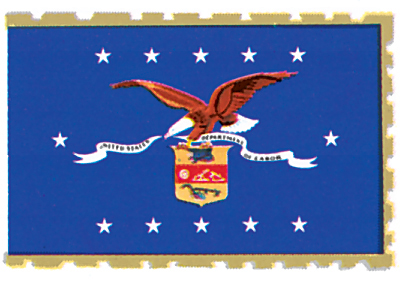Labor, Department of, is an executive department of the United States government that works to promote the welfare of wage earners. The department seeks to improve the economic position of workers in the United States, to better their working conditions, and to advance their opportunities for employment.

The secretary of labor, a member of the president’s Cabinet, heads the department. The president appoints the secretary subject to the approval of the U.S. Senate.
Functions.
The Department of Labor administers federal laws on minimum wages, overtime, child labor, and migrant workers and determines wage rates for work done under government contracts. A Labor Department agency called the Occupational Safety and Health Administration (OSHA) develops and enforces job safety and health standards for most U.S. industries. 
The Labor Department administers federal laws on workers’ compensation programs and enforces legal standards for the funding and operation of private pension and welfare plans. It also oversees the nation’s unemployment insurance programs.
The department works to reduce unemployment by providing job training for disadvantaged young men and women. The department helps people find jobs and helps businesses fill jobs. The department also gives local governments funds to establish and maintain their own job training programs for disadvantaged and unemployed people. In addition, it develops apprenticeship standards for the training of skilled workers.
The Labor Department enforces federal regulations that require businesses doing work for the U.S. government to maintain nondiscriminatory hiring and employment practices. These regulations are designed to guarantee equal employment opportunity to ethnic minorities, women, disabled people, and veterans.
The department administers laws that require the fair election of labor leaders and the publication of accurate union financial reports. In addition, it promotes cooperation between labor unions and employers.
Another important Labor Department function is that of serving as the U.S. government’s chief fact-finding agency in the field of labor economics. The department’s Bureau of Labor Statistics collects, analyzes, and publishes information on employment and unemployment, wages and industrial relations, occupational safety and health, and productivity and technology. The bureau prepares the Consumer Price Index (CPI), the most widely used measurement of price trends in the United States.
The department’s website at http://www.dol.gov presents additional information on its activities.
History.
In 1884, Congress established a Bureau of Labor in the Department of the Interior. In 1888, Congress gave the bureau independent status as the Department of Labor. In 1903, Congress established the new Department of Commerce and Labor and made the Department of Labor a bureau in it.
In 1913, President Woodrow Wilson signed a law creating an independent Department of Labor. The office of secretary of labor became the first Cabinet-level office to be occupied by a woman when Frances Perkins was appointed to the post in 1933.
